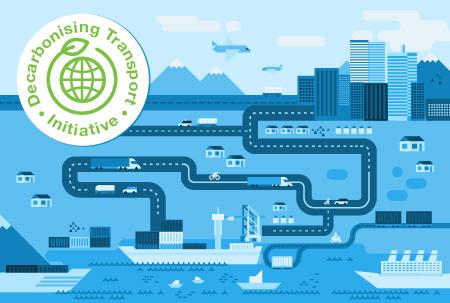On Course Towards Carbon-neutral Shipping?

The issue
If no drastic action is taken, CO2 emissions from international shipping could increase between 50% and 250% by 2050
Maritime transport emitted 938 tonnes of CO2 in 2012
This represented 2.6% of total global carbon emissions. By 2050, shipping CO2 emissions are projected to increase between 50% and 250% if no drastic action is taken. In order to reverse this trajectory, the 174 member states of the International Maritime Organisation (IMO) adopted an “Initial IMO Strategy on reduction of Greenhouse Gas emissions from ships” (or “Initial Strategy” for short) in April 2018. The Initial Strategy’s declared aim is to phase out greenhouse gas (GHG) emissions from shipping “as soon as possible in this century”. More specifically, the strategy also sets specific emission targets for the shipping sector.
Shipping’s first-ever absolute emissions target awaits implementation
The IMO’s Initial Strategy sets the ambition to reduce the total annual GHG emissions of international shipping “by at least 50% by 2050 compared to 2008”. In addition to this absolute emission target, the Initial Strategy includes carbon intensity targets for international shipping. These impose a reduction of carbon intensity “by at least 40% by 2030”. They also commit signatories to “pursuing efforts towards 70% [reduction] by 2050” compared to 2008. The Initial Strategy includes a list of “candidate measures” that, if implemented, could contribute to achieving the targets. Debate now centres on which set of measures will make the strategy successful.
Key insights
Using only currently known technologies can already eliminate annual shipping CO2 emissions equal to those of 185 coal-fired power plants
Lower shipping emissions will come from new technologies, improved operations and alternative fuels
Improving the energy efficiency of ships through technological measures can yield part of the needed emission reductions. Ready and available options here include hull design improvements (for instance lighter materials and more slender designs), air lubrication and bulbous bows to reduce friction, or waste heat recovery as a source of energy. Operational measures such as reduced speeds (“slow steaming”), smoother ship-port interfaces and bigger ships that carry more freight in relation to energy used could achieve further emission reductions. Finally, switching from oil to alternative fuels and renewable energy can cut shipping’s carbon emissions.
Alternative fuels can deliver the biggest cut in shipping CO2
Alternative fuels and renewable energy can deliver much of the required reductions. Advanced biofuels are already available, albeit in limited quantities. Gradually, they should be complemented by other natural or synthetic fuels such as hydrogen, methanol and ammonia. Wind assistance for ships could reap additional reductions. The first electric ships already provide transport on short-distance routes.
Maximum deployment of currently known technologies could decarbonise maritime shipping almost completely by 2035
Only a combination of operational measures, technical innovation and alternative fuels will deliver sufficient CO2 reductions
The quickest emissions reductions could be achieved by implementing known technologies and adopting new operational standards. The largest reductions could come from switching to alternative fuels, but the transition to new sources of energy will take time. Any pathway to carbon-neutral shipping will thus need to make use of all three levers at the disposal of policy makers, ship owners and naval architects.
The low price of fossil ship fuel is a major obstacle for decarbonisation
The current price of ship fuel does not reflect the costs created by climate change. As a result, some of the alternative propulsion technologies that emit less carbon dioxide are more expensive than oil-based fuel. Building zero-carbon vessels is also more expensive than the construction of conventional vessels. Retrofitting traditional ships requires capital that ship-owners often will not invest. However, costs will come down as larger numbers of zero- and low-carbon ships are ordered. Regulation or financial incentives can make them technologically feasible and their adoption commercially viable.
To Dos
Regulators can support the uptake of low- and zero-carbon ships through more stringent energy efficiency targets, speed limits and a low-carbon fuel standard
Strengthen mechanisms that will increase the use of alternative ship fuels
Incentives for promoting the uptake of alternative fuels deserve more attention. For the moment, discussions at the IMO focus mostly on measures to make ship design and the operation of vessels more energy efficient. Working out effective mechanisms to accelerate the transition to alternative ship fuels should be pursued in parallel. Such mechanisms could include a low-carbon fuel standard for the maritime sector to decrease the carbon intensity of ship fuel gradually, similar to practices in road transport.
Develop carbon pricing schemes for shipping
Financial incentives will reduce the current price gap between conventional ship fuel and more sustainable options. These could include a carbon price for international shipping to use market mechanisms for optimal resource allocation. Receipts from a carbon-pricing scheme could fund further research and development in green shipping or ship retrofitting programmes. They could also help to mitigate adverse impacts of decarbonisation on trade in least developed countries and small island developing states.
Further reading: Decarbonising Maritime Transport: Pathways to Zero-Carbon Shipping by 2035 (ITF 2018)
Subscribe to ITF Policy Briefs
This report is part of the Decarbonising Transport initiative